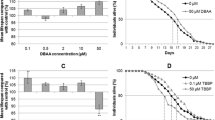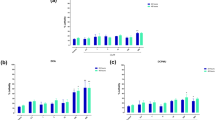Abstract
Perfluorooctane sulfonate (PFOS) is a persistent organic pollutant. Although multiple adverse effects of PFOS have been demonstrated, whether PFOS can accelerate aging and affect animal longevity remains unknown. In Caenorhabditis elegans, we found that a 50 h exposure to 0.2–200 µM PFOS reduced lifespan in a concentration dependent manner. In transgenic nematodes, lifespans are affected by mutations of daf-16, daf-2 or age-1 genes, which are related to the Insulin/IGF-1 Signaling pathway (IIS). PFOS exposure caused an additional reduction in average lifespan in daf-2(e1370) and daf-16b(KO) nematodes. In contrast, daf-16(mu86) nematodes showed no additional reduction with PFOS exposure and age-1(hx546) mutants did not exhibit a reduction in lifespan with PFOS exposure, compared with wildtype nematodes. Overall, our findings demonstrate that PFOS exposure accelerates aging and shortens longevity of animals. The PFOS-induced effect may involve genes of the IIS pathway, particularly daf-16 and age-1.



Similar content being viewed by others
References
Ahrens L, Bundschuh M (2014) Fate and effects of poly- and perfluoroalkyl substances in the aquatic environment: a review. Environ Toxicol Chem 33:1921–1929
Apfeld J, Kenyon C (1998) Cell nonautonomy of C. elegans daf-2 function in the regulation of diapause and life span. Cell 95:199–210
Brenner S (1974) The genetics of Caenorhabditis elegans. Genetics 77:71–94
Chen N, Li J, Li D, Yang Y, He D (2014) Chronic exposure to perfluorooctane sulfonate induces behavior defects and neurotoxicity through oxidative damages, in vivo and in vitro. PLoS One 9:e113453
Clancy D, Birdsall J (2013) Flies, worms and the free radical theory of ageing. Ageing Res Rev 12:404–412
Ghazi A (2013) Transcriptional networks that mediate signals from reproductive tissues to influence lifespan. Genesis 51:1–15
Hansen K, Johnson HO, Eldridge JS, Butenhoff JL, Dick LA (2002) Quantitative characterization of trace levels of PFOS and PFOA in the Tennessee River. Environ Sci Technol 36:1681–1685
Hertweck M, Gobel C, Baumeister R (2004) C. elegans SGK-1 is the critical component in the Akt/PKB kinase complex to control stress response and life span. Dev Cell 6:577–588
Hu XZ, Hu DC (2009) Effects of perfluorooctanoate and perfluorooctane sulfonate exposure on hepatoma Hep G2 cells. Arch Toxicol 83:851–861
Hu J, Yu J, Tanaka S, Fujii S (2011) Perfluorooctane sulfonate (PFOS) and perfluorooctanoic acid (PFOA) in water environment of Singapore. Water Air Soil Poll 216:179–191
Johnson TE, Tedesco PM, Lithgow GJ (1993) Comparing mutants, selective breeding, and transgenics in the dissection of aging processes of Caenorhabditis elegans. Genetica 91:65–77
Kaletta T, Hengartner MO (2006) Finding function in novel targets: C. elegans as a model organism. Nat Rev Drug Discov 5:387–398
Kannan K, Yun SH, Rudd RJ, Behr M (2010) High concentrations of persistent organic pollutants including PCBs, DDT, PBDEs and PFOS in little brown bats with white-nose syndrome in New York, USA. Chemosphere 80:613–618
Kenyon C (2011) The first long-lived mutants: discovery of the insulin/IGF-1 pathway for ageing. Philos Trans R Soc Lond B Biol Sci 366:9–16
Kwon ES, Narasimhan SD, Yen K, Tissenbaum HA (2010) A new DAF-16 isoform regulates longevity. Nature 466:498–502
Lau C, Anitole K, Hodes C, Lai D, Pfahles-Hutchens A, Seed J (2007) Perfluoroalkyl acids: a review of monitoring and toxicological findings. Toxicol Sci 99:366–394
Lee HG, Lee YJ, Yang JH (2012) Perfluorooctane sulfonate induces apoptosis of cerebellar granule cells via a ROS-dependent protein kinase C signaling pathway. Neurotoxicology 33:314–320
Leung MCK, Williams PL, Benedetto A, Au C, Helmcke KJ, Aschner M, Meyer JN (2008) Caenorhabditis elegans: an emerging model in biomedical and environmental toxicology. Toxicol Sci 106:5–28
Libna N, Berman JR, Kenyon C (2003) Tissue-specific activities of C. elegans DAF-16 in the regulation of lifespan. Cell 115:489–502
Lin K, Hsin H, Libina N, Kenyon C (2001) Regulation of the Caenorhabditis elegans longevity protein DAF-16 by insulin/IGF-1 and germline signaling. Nat Genet 28:139–145
Mariussen E (2012) Neurotoxic effects of perfluoroalkylated compounds: mechanisms of action and environmental relevance. Arch Toxicol 86:1349–1367
Meng J, Wang T, Wang P, Zhu Z, Li Q, Lu Y (2015) Perfluoroalkyl substances in daling river adjacent to fluorine industrial parks: implication from industrial emission. Bull Environ Contam Toxicol 94:34–40
Miralles-Marco A, Harrad S (2015) Perfluorooctane sulfonate: a review of human exposure, biomonitoring and the environmental forensics utility of its chirality and isomer distribution. Environ Int 77:148–159
Murphy CT, McCarroll SA, Bargmann CI, Fraser A, Kamath RS, Ahringer J, Li H, Kenyon C (2003) Genes that act downstream of DAF-16 to influence the lifespan of Caenorhabditis elegans. Nature 424:277–284
Paiano V, Fattore E, Carra A, Generoso C, Fanelli R, Bagnati R (2012) Liquid chromatography-tandem mass spectrometry analysis of perfluorooctanesulfonate and perfluorooctanoic Acid in fish fillet samples. J Anal Methods Chem 2012:719010
Sinclair E, Mayack D, Roblee K, Yamashita N, Kannan K (2006) Occurrence of perfluoroalkyl surfactants in water, fish, and birds from New York State. Arch Environ Contam Toxicol 50:398–410
Tatar M, Bartke A, Antebi A (2003) The endocrine regulation of aging by insulin-like signals. Science 299:1346–1351
Xu D, Jin J, Shen T, Wang Y (2013) Effect of perfluorooctane sulfonate on the conformation of wheat germ acid phosphatase. Bull Environ Contam Toxicol 91:577–582
Zareitalabad P, Siemens J, Hamer M, Amelung W (2013) Perfluorooctanoic acid (PFOA) and perfluorooctanesulfonic acid (PFOS) in surface waters, sediments, soils and wastewater—a review on concentrations and distribution coefficients. Chemosphere 91:725–732
Acknowledgments
This study was supported by National Science and Technology Major Project of China (No. 2013ZX07310-001-04) and a grant from the Natural Science Foundation of Shanghai (No. 16ZR1409300) for Defu He. Thanks for Caenorhabditis Genetics Center contributing transgenic strains.
Author information
Authors and Affiliations
Corresponding author
Rights and permissions
About this article
Cite this article
Xu, T., Li, P., Wu, S. et al. Chronic Exposure to Perfluorooctane Sulfonate Reduces Lifespan of Caenorhabditis elegans Through Insulin/IGF-1 Signaling. Bull Environ Contam Toxicol 97, 119–123 (2016). https://doi.org/10.1007/s00128-016-1808-5
Received:
Accepted:
Published:
Issue Date:
DOI: https://doi.org/10.1007/s00128-016-1808-5




